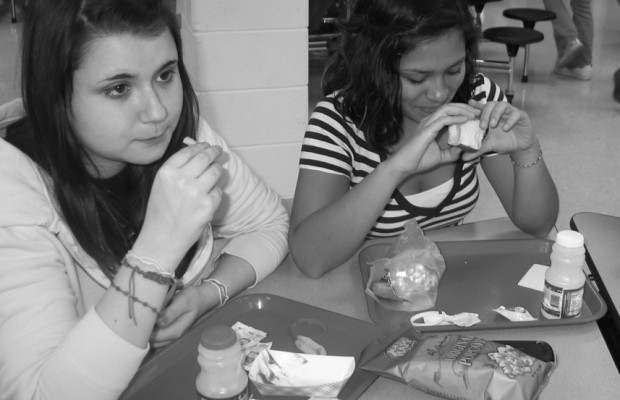Lost in Translation: School meal legislation doesn’t play out as planned

Sara Gabriele/Staff Writer
We often forget that with any attempt to effect societal change, there is usually a gap between what is planned and what actually happens. Nowhere is this more apparent than in politics. Legislation proposed to solve a pressing problem is drafted into a perfectly worded, visionary bill and, with a flourish of a pen, the issue is supposedly fixed. What actually happens when it comes to implementing it on the ground level is an entirely different story. This is illustrated particularly well with the recent legislation to improve school lunches in the United States.
The legislation to improve school lunches was proposed as a way to address the escalating childhood obesity epidemic in America. It required schools to take a look at their menus and rework them so they contain less saturated fat, sodium, sugar etc. Schools were also asked to provide more fresh fruits and vegetables so that school meals, which often contained upwards of 1,000 calories and the fat content for an entire day, would at the very least stop exacerbating problem. Not that wild of a proposition — but as with many pieces of legislation, it did not account for many of the complexities that are often encountered when laws are translated into action. What resulted from this new piece of legislation is something that even has the teachers whining.
Now, there isn’t only one way to make food taste good. You can load it up with fat, sugar and salt, which our taste-buds are hardwired to crave, or you can use fresh ingredients and actually cook them to make a meal. The first is obviously the cheaper alternative and has been what most schools have been relying on for years. It’s cheap and easy; schools can use the most inexpensive, lowest quality ingredients because, after adding a pound of butter, a cup of sugar and plenty of sodium, almost anything will taste pretty darn good. It also allows them to use ingredients that are pre-made, or so stacked with preservatives that they can sit in a box without being refrigerated for months, in order to cut costs.
The second method for making something taste good, cooking food with fresh ingredients, takes more time, effort and money. However, the resulting dishes taste even better than the former and as a result of using fresh, authentic ingredients, these dishes also happen to be healthier.
What schools have done in reaction to the new regulations has not been to move towards using better ingredients and actually cooking meals, but rather to simply take out much of the fat and sugar from their existing menu. It should come as no surprise that doing this makes meals taste like cooked cardboard. When you’re building meals from the lowest quality ingredients and just adding the fat and sodium on top to make it taste good, what do you expect is going to happen when you take out the fat and sodium?
To be fair, it is not without reason that schools resorted to this. According to some estimates, schools only have around $1 to $2 to spend per meal. With the pressure to instantly meet the new regulations and with very little extra money handed to them, schools really didn’t have much opportunity to brainstorm alternatives. The lunch system is constrained by many factors, and the added pressures and lack of funding have made it very difficult to do anything but just stick with their regular menus, minus some of the fat and sugar.
Cooking fresh food takes more time, effort, better facilities and, you guessed it, more money. However, it’s not impossible to do, especially if you implement it in small steps. All around the country and in our own state, schools are moving towards this alternative. Independence has recently begun cooking more of their school lunch items from scratch and has built gardens where students plant and harvest the food that is then used in their lunches. Near Oelwin and at a Montessori school in Des Moines, similar changes are occurring. In Cedar Falls, the Malcom Price Laboratory School makes all their school lunches from scratch and primarily uses locally grown ingredients.
What these schools are moving towards is the sustainable healthy food envisioned by the legislation that doesn’t have students and staff gagging. The Grass Roots Cafe at Price Lab, for example, has a menu that consists of items such as hamburgers, pizza and chicken linguini. However, they’re cooked from local meat, real cheese and fresh vegetables. The result? Real food that tastes good and, as an added bonus, is healthy.
These schools haven’t achieved this easily. It is a hard transition to make and, frankly, it may not be all that realistic for schools such as Cedar Fall High School. After all, we are a much larger school, which makes it all the more difficult. But implementing the concept on a smaller scale is not a ridiculous proposition.
Why not have a salad bar or try getting milk from Hansons? Why not try to get locally produced beef for one meal a week? Why not start purchasing apples from Iowa farmers instead of shipping them from across the country in bulk?
Students should have the option to get a Chocolate Chunk Rice Krispie square and chips al la carte if they so desire, but they should also have the choice to get a healthy, cooked meal that won’t end up stockpiling plaque from saturated fat in their arteries. Simply taking out fat and sugar from meals without moving towards using better quality ingredients does not provide students with fair alternative.
The legislation directed at improving school lunches does not give schools much of a hand. In fact, it makes it harder for them in some respects because of the pressure for schools to instantaneously meet new guidelines without a lot of additional funding. It could, however, be seen as an opportunity for schools demonstrate their capacity to create innovative and creative alternatives. After all, when has legislation ever translated easily into a direct product? That’s what people on the ground level have to figure out.









You must be logged in to post a comment Login